Our Even Warlock deck guide takes a look at this popular Warlock archetype in Rastakhan’s Rumble. Our guide features a mulligan guide, play strategy, card substitutions, deck win-rates, and goes through the ins-and-outs of slow and aggressive matchups!
Introduction to Even Warlock
Handlock. Now that’s a blast from the past. Once upon a time, Handlock was one of the dominant decks in Hearthstone, but it had not been seen for a while prior to The Witchwood.
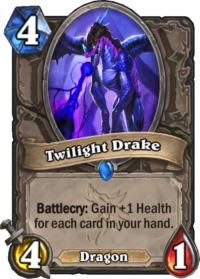
Handlock got its name from the huge hand size it maintained for cards that benefited from having other cards in hand, Twilight Drake and Mountain Giant. Because the Warlock Hero Power trades Health for cards, it was also natural for Handlock to use cards that benefit from losing Health, especially Molten Giant. Opponents needed to plan carefully when to lower the Health of a Handlock, because once you got them low, the swing of Molten Giants and either Defender of Argus or Sunfury Protector meant that next you would be facing a huge Taunt wall through which you could not finish off the Warlock, and those Giants would promptly proceed to smack you in the face.
The downfall of Handlock came from two sources. The obvious one was the nerf to make Molten Giant cost 25, which was later reverted when Molten Giant was moved to the Hall of Fame and removed from Standard format. The second source was the increased power level of the game itself: toying with your life total is risky business if many of the meta decks are able to burst you down from 15 Health or more.
However, right now things look a bit differently. Mountain Giant and Twilight Drake can still be threatening when played with full hand in the mid game. Molten Giant is no longer around, but Hooked Reaver is somewhat of a replacement. But why would you play Handlock over Control or Cube builds?
The answer is Genn Greymane and turn three Mountain Giants (when on the coin)! The defining feature of Even Warlock is that it is the fastest deck to play big minions, and it is definitely an ability worth paying attention to. Even Handlock also makes good use of the classic Taunt-providing cards, which makes it feel like Handlock, even though it is not quite the same deck anymore.
Even Warlock Deck List
We’ll be updating all of our guides for Rastakhan’s Rumble in the near future!
Check out alternative versions of this deck on our Even Warlock archetype page!
Even Warlock Card Choices
At the very core of Handlock is the threat and Taunt package. You want big minions on the board, and you want them to have Taunt if needed:
- Mountain Giant – The main threat of the deck, coming to a board near you as early as turn three.
- Twilight Drake – The secondary early-game big minion.
- Hooked Reaver – Swing-providing four-mana 7/7 Taunt, when your Health gets low. Sometimes a plain 4/4 for tempo.
- Sunfury Protector – Cheap minion that gives Taunt.
- The Lich King is kind of the odd one here, but it is a core card. It comes down a little later than the others, but it is a big Taunt minion with an upside, and the deck needs enough big minions to keep applying pressure. In the current card pool, there are no serious alternatives to the King.
- Bloodreaver Gul'dan – Bloodreaver Gul’dan is a big late game tempo push, usually made to close out the game quickly. While you sacrifice the cheaper Hero Power, you get a new, powerful one instead and you re-summon all your Demons. With a few threats on the board and a great Hero Power, you want to close out the game quickly, before running out of steam. Alternatively, it’s also a great defensive option vs Aggro if you survive that long.
Another package that you need is the removal package. All of Warlock’s good removal pieces are even-cost cards, so there are plenty of options to choose from.
The core removal package:
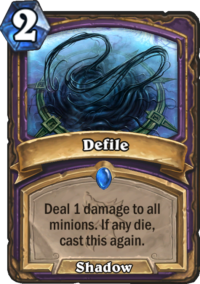
- Defile – Key early-game removal piece, especially great against Paladin.
- Hellfire – Flexible removal piece that also provides some reach through face damage.
- Lesser Amethyst Spellstone – Removal, and a lot of it when buffed, together with healing.
These removal pieces are simply too good not to include and form the basis of your control capabilities.
Next we arrive at a more controversial territory. Choices need to be made, as there is not enough room for everything.
The optional removal pieces:
- Spirit Bomb – Spirit Bomb is a one mana cheaper version of Shadow Bolt. Is it worth paying 4 life for 1 mana? Difficult to say, but Even Warlock can’t access the other spell anyway, so Spirit Bomb might as well be its early-mid game removal option.
- Shadowflame – Removal piece that can be used to clear Taunt walls, so it can also be used while on the offense. Effective use requires including Ancient Watcher in the deck as well, old-school Handlock style.
- Siphon Soul – Powerful single-target hard removal. Snipes away Taunts or big threats.
- Twisting Nether – Full board clear. Unfortunately, also wipes your own board, and you’re playing a proactive deck that relies on minions for damage, so you don’t really want to do that.
There are another two core cards left:
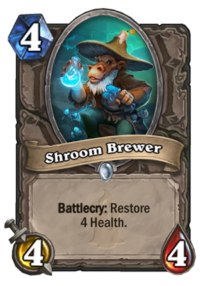
- Genn Greymane – Needed to reduce the cost of the Hero Power. Also a reasonable threat itself, even if it is nothing special.
- Shroom Brewer – Seriously, this card is incredibly important for the archetype. Not only can it be used to heal your Hero, but it can also be used to heal your major threats, preventing the opponent from removing them as easily. Healing a Mountain Giant with Shroom Brewer is perfectly fine.
After the threats, removal pieces, and other core cards are in the deck, all that remains is to fill up the list with some more defensive tools and tech cards.
Defensive and tech toolkit:
- Sacrificial Pact – In a meta full of other Warlock, Sac Pact can be one of the best techs you can put into your deck. Not only it clears a (potentially big) threat for 0 mana, but it also heals you up for 5.
- Acidic Swamp Ooze – The ideal weapon removal tool for the deck. Cheap, so you can also do other things on the same turn.
- Demonic Project – Is your opponent ready to unleash his deadly combo featuring Malygos, Shudderwock, Mecha'thun etc.? Well, just turn them into Succubus. Amazing tech card vs Combo decks, okay vs Control, not so much against other builds.
- Doomsayer – Early-game board clear that can allow you to set up for your own minions. Not that impressive in Handlock later in the game, as your own game is heavily board-based.

- Spellbreaker – Even-cost Silence effect. The deck cannot run Ironbeak Owl, which would go well with Defile.
- Plated Beetle – Early-game minion that can take effective trades and provides some Armor when killed.
- Vulgar Homunculus – Early-game Taunt minion that also buffs up your Lesser Amethyst Spellstone.
- Dread Infernal – Potential threat and additional removal tool. Buffs up your Lesser Amethyst Spellstone. It’s a Demon, so it gets revived by Gul’dan.
- Rin, the First Disciple – It’s an interesting choice, and doesn’t exactly fit into the deck’s game plan, but it comes handy in some slower matchups.
- Skulking Geist – If some key 1 mana spells are played in the meta, Skulking Geist can be a good tech to answer them. Right now, Naturalize is a very popular Druid card, and you generally want to get rid of it as soon as you can.
- The Black Knight – A very old tech card, which was forgotten through majority of Standard. Now that lots of decks run Taunts (The Lich King is the most popular late game threat, for example), it’s back in business.
Even Warlock Mulligan Strategy & Guide
You really want to find your early threats. Even in the matchups where you are on the defense, you need to turn things around and start hitting face with big minions, you cannot stall indefinitely. Look for the appropriate removal pieces, but do not ignore the importance of your big minions.
VS Fast Decks
Higher Priority (Keep every time)
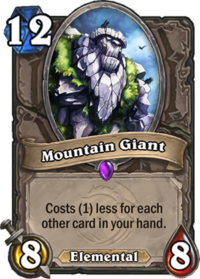
- Mountain Giant – Your main game-winning tool.
- Defile or Hellfire – Your main board clears. You keep one or the other depending on the matchup – if your opponent will likely have a 1-health minion to start the chain, Defile is better. On the other hand, against decks with 2-3 health early game minions, Hellfire is better.
- Plated Beetle – Good Turn 2 or 3 play vs Aggro – it often trades into something and gives you some extra Armor.
- Vulgar Homunculus – Early-game Taunt minion + it can potentially upgrade your Spellstone.
Lower Priority (Keep only if certain conditions are met)
- Acidic Swamp Ooze – Against decks that run weapons.
- Twilight Drake – Your secondary big minion, not needed against fast decks if you have a Giant already.
- Lesser Amethyst Spellstone – With Homunculus. It’s not great without upgrading, but even at 5 damage/healing it’s already very efficient for 4 mana.
- Shroom Brewer – Against decks that will want to rush you down and have a lot of burn damage, such as Tempo Mage.
VS Slow Decks
Higher Priority (Keep every time)
- Mountain Giant – Your main game-winning tool.
- Twilight Drake – Your secondary big minion. Against slow decks, you keep as many Giants and Drakes as you can find – you pretty much hard mulligan for those.
Lower Priority (Keep only if certain conditions are met)
- Acidic Swamp Ooze – Against weapons decks.
- Skulking Geist – Against Druid, burning Naturalizes is important.
Even Warlock Win Rates
Winrate stats are currently unavailable for this deck at the moment!
Even Warlock Play Strategy
Even Handlock is not a fatigue deck. Do not be fooled by the control cards in the deck. This is a deck that wants to win games by being active and hitting the opponent in the face with huge minions. It plays the control role only against most aggressive builds, and even then not always – sometimes you win those matchups by dropping an early Giant and going face.
When you’re on the coin, you can play Mountain Giant as early as turn three: Hero Power on turn one, Hero Power on turn two, play Mountain Giant on turn three or optionally coin Twilight Drake on turn three.
When you’re on the play, you can play Mountain Giant on turn four: Hero Power on turn one, Hero Power on turn two, Hero Power and play a two-cost card on turn three, and either Hero Power and play Mountain Giant on turn four or play Twilight Drake on turn four.
This early-game power makes all the difference and is the reason to play Even Handlock in the first place. Even though you do not get to play Mountain Giant until turn four when you’re on the play, the same as other decks, the cheaper Hero Power allows you to weave in a two-drop (such as Doomsayer, which can set up the board really nicely for the Giant) on turn three without compromising your ability to play the Giant.
Once you have your big minions on the board, you can Taunt them up with Sunfury Protector – or you can Taunt up other minions to prevent the opponent from hitting back at your big ones. You can also heal them up with Shroom Brewer to keep them out of reach of the opponent’s removal.
VS Aggro Decks
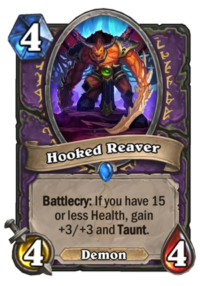
In the current meta, aggressive decks do not run out of steam easily. You need a plan on how to take the fight to them. Sometimes, the Mountain Giant plan works: you rush for your Giant, clear the board afterwards, and proceed to hit them in the face and Taunt up your big minion (also doable with Twilight Drake to an extent) or play a buffed-up Hooked Reaver to take the heat.
However, sometimes the pressure is too much to get to that Giant and you need to improvise an alternative game plan where you do not tap as much. Defile, Plated Beetle and Vulgar Homunculus are often the cornerstones of the alternative early game, where you focus on stabilizing without the big minions and look for a swing a little later in the game. Hooked Reaver can be that swing card if you drop to 15 health or below.
Pay close attention to your Health total and the opponent’s expected reach. Especially Leeroy Jenkins can be scary if you have no Taunt minions up, even more so in combination with something like Cold Blood. Odd Paladins want to Level Up! their Silver Hand Recruits, and Tempo Mages have a lot of reach in form of Frostbolts, Fireballs and sometimes even a Pyroblast. Silence effects (or other ways to get through a Taunt) are also quite common, so don’t bank on a big Taunt to always save you.
Heal as needed, but if you have a Hooked Reaver available, it may be desirable to temporarily dip to under 15 Health to play it, and heal up afterwards. If you’re near 15 health and you can hold out for an extra turn, you can delay your healing card. Don’t do it at the expense of tempo or leaving an important threat on the board. For example, if you can choose between playingShroom Brewer or not doing anything, then the choice is obvious – you play it. Similarly, if you can clear Vicious Fledgling or Hench-Clan Thug with your Spellstone, you do it despite delaying your Reaver (if you don’t, things can go south really quickly).
VS Control Decks
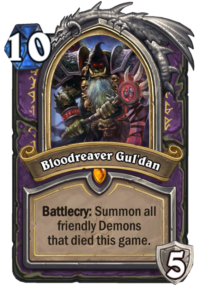
Against slow decks, you want to tap, tap, and tap at the start. You do not have to worry about your life total, your worst fear is not finding Mountain Giant early. Get big early and protect and heal your big minions so that they can push damage. You need to self-inflict damage to get Hooked Reaver buffed up, but sometimes it can also get the job done as a 4/4, adding a bit more power to your push. While it might be uncommon at the lower ranks, better opponents will actually try to not damage you to keep you out of buffed Hooked Reaver range. They know that a 4 mana 7/7 Taunt is a big Tempo swing in your favor and can win you the game, while a dead card in your hand is terrible since it clogs it. If you see them doing that, you probably don’t want to wait 5+ turns until you manage to get there yourself, if you have nothing to do you play them as 4/4’s. You still put a threat onto the board, and make your Bloodreaver Gul’dan better.
Play around the opponent’s key removal pieces, such as Shield Slam, Swipe and Hellfire by healing your minions. Avoid going too wide into a Psychic Scream or Brawl and keep track of which minions return to your hand and which ones die if the opponent plays Vanish. If you know that your opponent might play a big AoE, don’t play into it – keep 2-3 minions on the board at a time (depending on their size, if you already have a Giant and a Twilight Drake up, playing the third one is not a good idea – but if you have two 4/4’s, then you can drop another small-to-midrange minion if you need more pressure). On the other hand, against opponents with individual removal but no board clears, go for multiple minions at once.
You are the beatdown. You will inevitably lose a long game against most of the slow decks, but try to prevent the game from going long in the first place. Spellbreaker is your friend against Taunt minions, use it. While the early versions have used Demonic Project to counter the Combo decks, more up to date lists have dropped it for a few reasons. Not only combo decks are less popular than they were, but most of them are good matchups for you anyway (Togwaggle Druid, Shudderwock Shaman or Mecha’thun decks are solid or even great matchups anyway). On the other hand, the card doesn’t help much in other matchups. Still, if you keep facing combo decks, especially Malygos Druid, you might consider teching the card in.
Bloodreaver Gul'dan is often the final swing you need. If you know that you want to play it soon, prioritize some Demons. Even if Hooked Reaver is still a 4/4, for example, drop it just so it will die and you will get it back – it’s worth it. Also, try to bait an AoE board clear right before your Gul’dan turn. Play 3-4 minions on the board. If your opponent has no AoE, great, you deal a lot of damage and don’t play Gul’dan. And if he does – you get a refill and hopefully he has no other way to clear it. Use your Hero Power every single turn after playing him – either to clear minions and protect your own board (especially if your opponent still has lots of health), or use it to deal 3 damage per turn and put them on the clock (especially useful if your opponent is low on health and/or has limited life gain).
Even Warlock Card Substitutions
At around 7,000-10,000 Dust (depending on the list), Even Warlock is a rather high cost deck. Sadly, it can’t be made much cheaper, as the core of the deck is quite expensive. Some of the tech cards can be taken out, but lots of them are crucial. Here are the Epic & Legendary cards with potential replacements, although don’t expect to cut that much from the cost:
- Genn Greymane – Obviously, the main card in your deck – if you don’t have Genn, try out a a Control Warlock instead (but the deck has its own expensive minions).
- The Lich King – Not exactly a necessary core card, but it’s one of the best Even late game threats you can use. You can try out a second Dread Infernal or Primordial Drake instead if you face lots of board flood decks, or Argent Commander if you’re playing beatdown more often. If you face lots of slow decks, you can also try out a Siphon Soul.
- Bloodreaver Gul'dan – I feel like in the current form of the deck, Bloodreaver Gul’dan is a must. While Mountain Giants and such are still your main win condition, if you get into the late game, you might need that final tempo push DK Gul’dan provides. On top of that, it’s often a life-saved against Aggro – it gives you LOTS of healing and extra removals in the long run thanks to the Hero Power. If you don’t have it, but really want to play the deck, I’d probably go for Siphon Soul or Doomsayer (but those obviously are not good replacements).
- Mossy Horror & Skulking Geist – Tech cards, they work really well in the current meta, but they’re not absolutely necessary. They have no direct replacement, you can use any of the cards above.
- Mountain Giant – Probably the most important card in the deck after Genn himself, your main win condition. Can’t be replaced.

What happen to demonic project?
Now it looks like Even Tech Warlock. But why 2 Demonic Projets? So much hate on Malygos Druids these days.
But why 2 Demonic Projets? So much hate on Malygos Druids these days.  It’s a really good card especially with Sacrificial Pact, cause even if your opponent will get a nice demon it’s as good as dead and waste of his mana.
It’s a really good card especially with Sacrificial Pact, cause even if your opponent will get a nice demon it’s as good as dead and waste of his mana.